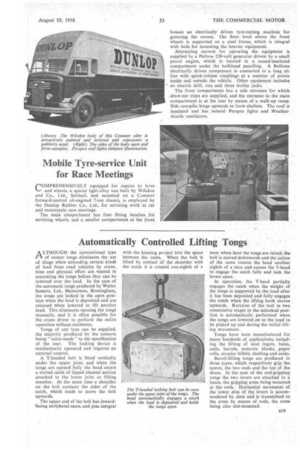Automatically Controlled Lifting Tongs
Page 53

If you've noticed an error in this article please click here to report it so we can fix it.
ALTHOUGH the conventional type of scissor tongs eliminates the use of slings when unloading certain kinds of load from road vehicles by crane, time and physical effort are wasted in separating the tongs before they can be lowered over the load. In the case of the automatic tongs produced by Walter Somers, Ltd., Halesowen, Birmingham, the tongs are locked in the open position when the load is deposited and are released when lowered to lift another load. This eliminates opening the tongs manually, and it is often possible for the crane driver to perform the entire operation without assistance.
Tongs of any type can be supplied, the majority produced by the concern being "tailor-made" to the specification of the user. The locking device is mechanically operated and requires no external control.
A T-headed bolt is fitted vertically under the upper joint, and when the tongs are opened fully the head enters a slotted catch of lipped channel section attached to the lower joint or lifting member. At the same time a shoulder on the bolt contacts the sides of the catch, which tends to move the bolt upwards.
The upper end of the bolt has inwardfacing peripheral cams, and pins integral with the housing project into the space between the cams. When the bolt is lifted by contact of the shoulder with the catch it is rotated one-eighth of a turn; when later the tongs are raised, the bolt is moved downwards and the action of the cams rotates the head another eighth of a turn and causes the T-head to engage the catch fully and lock the levers open.
In operation, the T-head partially engages the catch when the weight of the tongs is supported by the load after it has been deposited and fully engages the catch when the lifting hook moves upwards. Rotation of the bolt in two consecutive stages to the unlocked position is automatically performed when the tongs are lowered on to the load to be picked up and during the initial lifting movement.
Tongs have been manufactured for many hundreds of applications, including the lifting of steel ingots, bales, coils, barrels, concrete blocks, paper' rolls, circular billets, shafting and sacks.
Barrel-lifting tongs are produced in three types, which respectively grip the centre, the two ends and the top of the drum. In the case of the end-gripping tongs the two levers are attached to a beam, the gripping arms being mounted at the ends. Horizontal movement of the lower pins of the levers is accommodated by slots and is transmitted to the arms by means of rods, the arms being also slot-mounted.




































































































